Mike Simons feels strongly that the expectations that a truck driver trainer and driver trainee each have about and during their training periods should be shared one with the other.
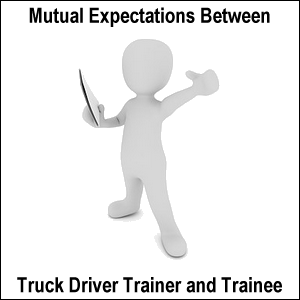 Much difficulty could be avoided if only the trainer and trainee discussed their individual goals and what they expect of each other during the training period.
Much difficulty could be avoided if only the trainer and trainee discussed their individual goals and what they expect of each other during the training period.
In fact, much of what the trainer and trainee expect should be mutual in nature:
- the trainer providing top-notch training and
- the trainee learning as much as possible,
- both respecting each other.
The subject of mutual expectations is important to us because the training that we both had could have been so much better.
Furthermore, this is important to Mike because he once was a driver trainer and in that capacity, he tried to straighten out the lack of teaching that one student co-driver received from someone who should never have been a driver trainer!
The failure of this trainer to train properly resulted in the trainee’s failure to get a truck driving job with the trucking company of his choice. Not good.
So, on this page, we will provide you with:
- a snapshot of our background as it pertains to being trained,
- what we expected of our own driver trainers,
- details about how we were trained (or not trained, as the case may be),
- what trainees should expect during training,
- an overview of what trainees will be entrusted with, and
- info about free downloads to help trainers and trainees.
Our Training Background
When we initially started our truck driving career fresh out of truck driver training school, Mike was assigned to a driver trainer named Ken who had 5 years of trucking experience before he decided to become a trainer.
Mike and Ken primarily did cross-country runs, pulling 48-foot and 53-foot dry van trailers, as well as double 28-foot pup trailers (aka “doubles”).
Mike and Ken did not discuss the expectations that they had of each other prior to beginning the 6-week training period.
Frankly, Mike didn’t know he was supposed to.
He was putting himself in his trainer’s hands, totally trusting that he knew what he was doing.
Vicki and her trainer Bill ran a dedicated account (for the most part) from northern South Carolina to central and northern Ohio.
This run allowed Vicki to come home on weekends, so this worked out well for her for the most part.
She drove typically late at night, and this prepared her well for our career together when she drove a lot of all-nighters.
The only trailers she pulled were long dry vans.
Mike came home only one time to see Vicki during training, the first weekend after starting.
Being away from each other for the 5 weeks that followed was rough emotionally.
Because our training took place in the days before cell phones, the only time that Mike got to talk with Vicki on the phone was on the weekends when Vicki was at home.
After our six weeks of individual training, we were assigned a double-decker tractor with a stand-up sleeper.
We took a few days off before coming out together as a husband-wife team. We drove together then for almost three years.
Our Expectations of Our Driver Trainers
When starting out in our training program, we didn’t know exactly what to expect, primarily because there were
- no written guidelines,
- no mutual expectations discussed before our individual first trips, and
- no final evaluation standards (at least as far as we knew).
In retrospect, this lack of documentation didn’t inspire much confidence!
Although we did not know how to express it as CDL students, we had
- an unwritten expectation of good training and
- an unwritten assumption that any training we received would totally prepare us (real-world experience aside) for entry into the trucking industry.
We reasoned that if we had received
- textbook training in the classroom;
- driving time on the driving range;
- driving time on the road; and
- a certificate from an accredited truck driver training school;
why would we not be ready after training?
After all, the training period is supposed to be the transition between being a student and being a full-fledged professional driver, right?
So, given that, we feel that when a driver trainee completes school and is assigned to a trainer, there ought to be a plumb line that enables him or her to know exactly what will be evaluated and how.
The driver trainer should evaluate — without bias or favoritism — what a driver trainee should know before he/she is released to drive for a trucking company.
Again, Mike never saw or was never informed about a guideline or evaluation.
As far as he knew, all the company had to go on was his trainer’s word — with nothing being written down and turned in to a training program overseer or supervisor.
Learn from his experience and set your expectations accordingly.
It is our strong opinion that, before you agree to work for a company as a driver trainee, you must find out how the driver trainer will evaluate your skill and knowledge during the training period.
If there are no forms with a measurable, clear-cut standard, how do you know if you will be prepared when the time comes that you are released to be on your own?
Quite simply, you don’t.
How We Were Trained
To this day, Mike feels that his trainer was generally concerned about only one thing: getting loads down the road so he could make money!
Frankly, that’s a problem that’s common among all trucking companies that expect a trainer-trainee team to run like a team.
The company may very well be more concerned about covering miles than getting a well-trained trainee.
In retrospect, here are some of the problem areas that Mike keenly remembers about areas that he had light exposure to in trucking school but which needed practical application in training:
Expectations about planning routes
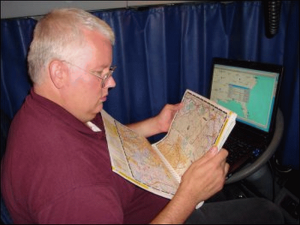 Ken didn’t sit down and show or test Mike on how to plan routes.Mike was familiar with a computer software program named “Auto Map” but couldn’t use it in the truck because he didn’t have a computer.You would have thought that with 5 years of experience, Mike’s driver trainer would have had lots of knowledge about truck routes, low clearances, restrictions and more that he was willing to share.In this photo, Mike is looking in his motor carriers atlas with his laptop computer running Auto Map in the background.
Ken didn’t sit down and show or test Mike on how to plan routes.Mike was familiar with a computer software program named “Auto Map” but couldn’t use it in the truck because he didn’t have a computer.You would have thought that with 5 years of experience, Mike’s driver trainer would have had lots of knowledge about truck routes, low clearances, restrictions and more that he was willing to share.In this photo, Mike is looking in his motor carriers atlas with his laptop computer running Auto Map in the background.
Expectations about balancing a heavy load
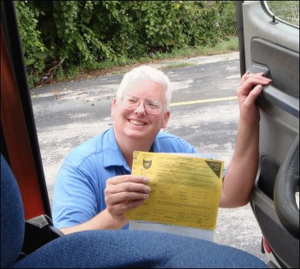 Ken didn’t show or test Mike on how to do this on single or double trailers.Scaling out a load and adjusting the fifth wheel were not on Ken’s agenda when training Mike.When it came to scaling out, Ken did it all.So much for mentoring the newbie.In this photo, Mike smiles because his CAT Scale ticket says that the weights on all axles of his truck are legal and well balanced.
Ken didn’t show or test Mike on how to do this on single or double trailers.Scaling out a load and adjusting the fifth wheel were not on Ken’s agenda when training Mike.When it came to scaling out, Ken did it all.So much for mentoring the newbie.In this photo, Mike smiles because his CAT Scale ticket says that the weights on all axles of his truck are legal and well balanced.
Expectations about using a log book
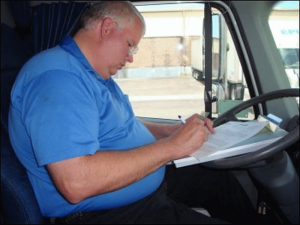 Other than bringing a line down from the sleeper berth to on-duty driving, Ken never elaborated on what Mike was supposed to know.Of course, Mike had some exposure to keeping a log book in trucking school, but real world application was sorely lacking.In this photo, Mike fills out a log sheet from his log book, resting on an aluminum forms holder on his steering wheel.
Other than bringing a line down from the sleeper berth to on-duty driving, Ken never elaborated on what Mike was supposed to know.Of course, Mike had some exposure to keeping a log book in trucking school, but real world application was sorely lacking.In this photo, Mike fills out a log sheet from his log book, resting on an aluminum forms holder on his steering wheel.
Expectations about equipment maintenance and repair
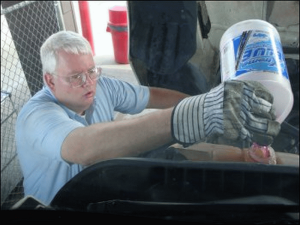 Because Ken never showed or tested Mike on this, Mike had only a basic idea about what to do when the truck needed to get into the shop for servicing and what to do when the truck required repair work.As Mike recalls, the truck that Ken and Mike drove never went into the shop for servicing the entire time Mike was in training.In this photo, Mike adds coolant to the reservoir at a time when there was a leak from a head gasket.It was a stopgap measure until the truck could get in the shop for repair work.
Because Ken never showed or tested Mike on this, Mike had only a basic idea about what to do when the truck needed to get into the shop for servicing and what to do when the truck required repair work.As Mike recalls, the truck that Ken and Mike drove never went into the shop for servicing the entire time Mike was in training.In this photo, Mike adds coolant to the reservoir at a time when there was a leak from a head gasket.It was a stopgap measure until the truck could get in the shop for repair work.
Expectations about pre-trip and post-trip inspections
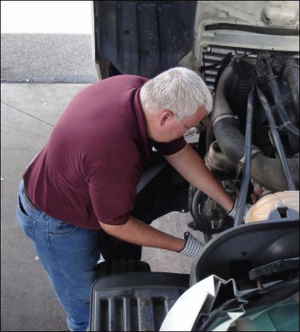 Although Mike had a good background in doing a pre-trip inspection, Ken never took the time to get out and show him what he did.He certainly never provided Mike with a pre-trip inspection checklist like we offer on our Free Downloads page.With the current, ever-increasing regulations on truck and trailer safety, you as a driver must know what to do on pre-trip inspections!There are times when you simply do not have the time to do a full-blown PTI.Your driver trainer should be able to show what will be sufficient when you’re pressed hard for time.In this photo, Mike is checking things under his truck’s hood during an inspection.
Although Mike had a good background in doing a pre-trip inspection, Ken never took the time to get out and show him what he did.He certainly never provided Mike with a pre-trip inspection checklist like we offer on our Free Downloads page.With the current, ever-increasing regulations on truck and trailer safety, you as a driver must know what to do on pre-trip inspections!There are times when you simply do not have the time to do a full-blown PTI.Your driver trainer should be able to show what will be sufficient when you’re pressed hard for time.In this photo, Mike is checking things under his truck’s hood during an inspection.
As if those items weren’t bad enough, there was a classic example of knowledge that only Ken could have provided but didn’t….
Connecting Doubles
When Mike trained under Ken, they pulled lots of doubles.
But Ken never showed Mike how to couple or uncouple doubles with the converter gear.
When Vicki trained under Bill, they never pulled doubles, so she didn’t know a thing about coupling or uncoupling them.
When we finished our individual training periods, we were sent out as a team and were assigned to pull our first set of doubles.
But we had no idea how to connect them!
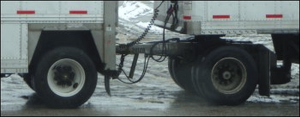 You can rest assured that others who circled the shipper’s parking lot that day saw us fumbling around trying to connect doubles for the first time — and correctly assessed that we were newbies.
You can rest assured that others who circled the shipper’s parking lot that day saw us fumbling around trying to connect doubles for the first time — and correctly assessed that we were newbies.
This photo shows a converter gear (or “con-gear” or dolly) between double trailers.
Notice that there are also connections between them with an electrical cord (or “pigtail”) and airlines.
This lack of training should never have happened.
Mike should have been instructed on how to couple and uncouple double trailers.
The only good things that came from that embarrassing training failure were that
- we eventually figured out how to do it and
- we are now writing about it as encouragement for you not to repeat this experience.
Money Hungry?
We think you get the general picture about how poor Mike’s training was.
He was pretty much left to fend for himself while his trainer made big money (miles plus training pay).
Mike says this regarding the expectations that a driver trainee should have:
“If your trainer is being paid to train you (and he/she is), then he/she needs to train you thoroughly and answer your questions in a way you will understand. If he/she is unwilling to answer your questions and help you get a good start, then you need to ask yourself why you should stay with him/her and not be assigned to someone else. The training you receive — or fail to receive — can either make you or break you.”
We reveal more about a training failure on our driver trainer page.
What Will Be Expected Of Trainees
Trainees need to understand that the OTR driving profession is not an occupation for the faint-hearted.
They need to be willing to work hard and be away from family and friends for days or even weeks at a time.
A good driver trainer can (or should) lay out expectations regarding what to expect when it comes to
- freight,
- being alone on the road,
- taking care of personal business from the road, and
- dealing with other problems you may face.
There are some really good driver trainers who will give you their cell phone number with instructions to call them when you need some guidance about what to do when you encounter a sticky situation.

 In these two photos, Mike is taking care of personal business.
In these two photos, Mike is taking care of personal business.
In the photo on the left, he is taking the waste holding tank from his portable toilet to a restroom to dump the contents.
In the photo on the right, he is toting two bags of ice to his truck to put them in his ice chest.
Trainees need to have a good idea of what it takes to get that load down the road with a minimum of problems and making all customers happy.
When we say “all customers,” that includes:
- the driver or fleet manager,
- the trucking company,
- the shipper who is counting on drivers to make on-time pickups, and
- the receiver (assuming a load is taken all the way to its final destination) who needs on-time deliveries.
What Trainees Will Be Entrusted With
When you are with a trainer and then eventually on your own as a driver, the plain, simple truth is that you will be entrusted with
- a tractor costing around $100,000 (or more),
- the value of the trailer, and
- the cost of the freight being hauled inside.
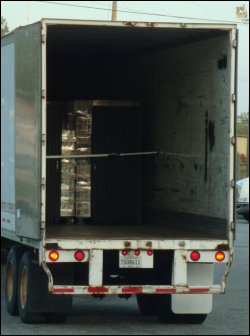 That freight could be worth tens or hundreds of thousands of dollars.
That freight could be worth tens or hundreds of thousands of dollars.
And when you get more experience, it could be worth even millions of dollars, like some of the loads that we have hauled.
If you haven’t already, adjust your expectations to needing to know about these things.
When you have a high value load, it’s a real good idea to know some basic security procedures ranging
- from keeping the load from coming up short on the final count at the shipper’s end
- to avoiding a hijacking situation during every inch of your route
- until you get to the receiver’s end.
You need to know the proper way to apply seals and if anything else is needed to cause a would-be thief to keep on looking for another trailer.
With all the new regulations being implemented by the federal government, you also must know what needs to be done concerning securing the load inside with load straps and locks.
The trailer pictured here has been properly loaded.
It isn’t fun at all to have a load shift because it wasn’t loaded properly and you as the driver will be responsible to go inside a hot trailer and restack all the boxes or pallets of product.
What We’re Offering You
When Mike was a trainer, he developed a series of sheets which we’ve adapted and are making available to you through our Free Downloads page.
In this way, we hope to assist both truck driver trainers and their driver trainees work through some mutual expectations and have some solid guidelines on how training should be done.
- Coupling Procedure Record – a record of each time the trainee (or student co-driver) couples (hooks or unhooks) a trailer during the training period, to make sure that enough experience is gained at doing this procedure.
- Drivers Orientation Trip Performance Evaluation – a form to be completed on a weekly basis by the trainer as the trainee is observed conducting job tasks. At the completion of the orientation trip, the trainer shall review the grading with the trainee.
- Driving Performance Evaluation – a sheet to be completed by the trainer on a weekly basis as the trainee is observed while driving. At the completion of the orientation trip, the trainer shall review the grading with the trainee.
- Mutual Expectations – Mike’s own personal list of expectations from both the student co-driver and driver trainer.
- On Road Scaling Worksheet – a sheet that the trainee (or student co-driver) completes each time a load is scaled
- Student Co-Driver Supply List – a suggested list of supplies that trainees should take so they can be prepared for their time out on the road. This differs from what we have on our packing list since an experienced driver trainer should have most truck-related items with him already.
- Trip Planning Worksheet – a sheet that the trainee (or student co-driver) fills out at each dispatch.
![]() Money saving tip: Think about your future.
Money saving tip: Think about your future.
If you’re a driver trainee and you have no expectations regarding your training, you may not be getting everything you need to succeed after your training period is over.
Not only that, but you could actually fail your road test and be forced to seek employment somewhere other than the trucking company of your choice.
Having a list of mutual expectations and clearly written guidelines with objective measures will help both you and your trainer.
Return from Mutual Expectations Between Truck Driver Trainer and Trainee to our Truck Driving Jobs page or our Truck Drivers Money Saving Tips home page.









